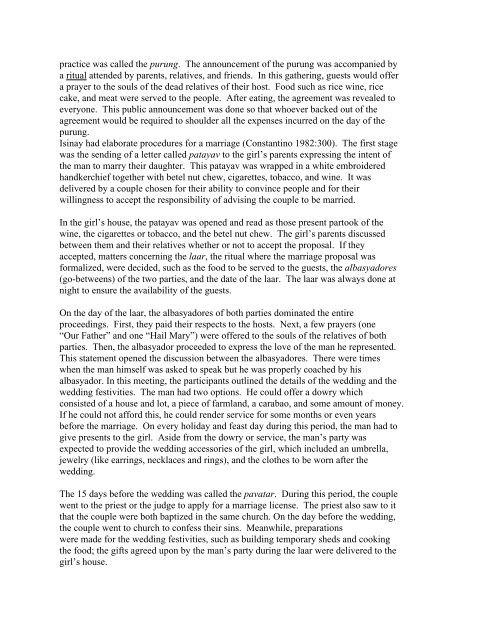“Isinay” is derived from the prefix “i” meaning “native, resident ...
“Isinay” is derived from the prefix “i” meaning “native, resident ...
“Isinay” is derived from the prefix “i” meaning “native, resident ...
Create successful ePaper yourself
Turn your PDF publications into a flip-book with our unique Google optimized e-Paper software.
practice was called <strong>the</strong> purung. The announcement of <strong>the</strong> purung was accompanied by<br />
a ritual attended by parents, relatives, and friends. In th<strong>is</strong> ga<strong>the</strong>ring, guests would offer<br />
a prayer to <strong>the</strong> souls of <strong>the</strong> dead relatives of <strong>the</strong>ir host. Food such as rice wine, rice<br />
cake, and meat were served to <strong>the</strong> people. After eating, <strong>the</strong> agreement was revealed to<br />
everyone. Th<strong>is</strong> public announcement was done so that whoever backed out of <strong>the</strong><br />
agreement would be required to shoulder all <strong>the</strong> expenses incurred on <strong>the</strong> day of <strong>the</strong><br />
purung.<br />
Isinay had elaborate procedures for a marriage (Constantino 1982:300). The first stage<br />
was <strong>the</strong> sending of a letter called patayav to <strong>the</strong> girl’s parents expressing <strong>the</strong> intent of<br />
<strong>the</strong> man to marry <strong>the</strong>ir daughter. Th<strong>is</strong> patayav was wrapped in a white embroidered<br />
handkerchief toge<strong>the</strong>r with betel nut chew, cigarettes, tobacco, and wine. It was<br />
delivered by a couple chosen for <strong>the</strong>ir ability to convince people and for <strong>the</strong>ir<br />
willingness to accept <strong>the</strong> responsibility of adv<strong>is</strong>ing <strong>the</strong> couple to be married.<br />
In <strong>the</strong> girl’s house, <strong>the</strong> patayav was opened and read as those present partook of <strong>the</strong><br />
wine, <strong>the</strong> cigarettes or tobacco, and <strong>the</strong> betel nut chew. The girl’s parents d<strong>is</strong>cussed<br />
between <strong>the</strong>m and <strong>the</strong>ir relatives whe<strong>the</strong>r or not to accept <strong>the</strong> proposal. If <strong>the</strong>y<br />
accepted, matters concerning <strong>the</strong> laar, <strong>the</strong> ritual where <strong>the</strong> marriage proposal was<br />
formalized, were decided, such as <strong>the</strong> food to be served to <strong>the</strong> guests, <strong>the</strong> albasyadores<br />
(go-betweens) of <strong>the</strong> two parties, and <strong>the</strong> date of <strong>the</strong> laar. The laar was always done at<br />
night to ensure <strong>the</strong> availability of <strong>the</strong> guests.<br />
On <strong>the</strong> day of <strong>the</strong> laar, <strong>the</strong> albasyadores of both parties dominated <strong>the</strong> entire<br />
proceedings. First, <strong>the</strong>y paid <strong>the</strong>ir respects to <strong>the</strong> hosts. Next, a few prayers (one<br />
“Our Fa<strong>the</strong>r” and one “Hail Mary”) were offered to <strong>the</strong> souls of <strong>the</strong> relatives of both<br />
parties. Then, <strong>the</strong> albasyador proceeded to express <strong>the</strong> love of <strong>the</strong> man he represented.<br />
Th<strong>is</strong> statement opened <strong>the</strong> d<strong>is</strong>cussion between <strong>the</strong> albasyadores. There were times<br />
when <strong>the</strong> man himself was asked to speak but he was properly coached by h<strong>is</strong><br />
albasyador. In th<strong>is</strong> meeting, <strong>the</strong> participants outlined <strong>the</strong> details of <strong>the</strong> wedding and <strong>the</strong><br />
wedding festivities. The man had two options. He could offer a dowry which<br />
cons<strong>is</strong>ted of a house and lot, a piece of farmland, a carabao, and some amount of money.<br />
If he could not afford th<strong>is</strong>, he could render service for some months or even years<br />
before <strong>the</strong> marriage. On every holiday and feast day during th<strong>is</strong> period, <strong>the</strong> man had to<br />
give presents to <strong>the</strong> girl. Aside <strong>from</strong> <strong>the</strong> dowry or service, <strong>the</strong> man’s party was<br />
expected to provide <strong>the</strong> wedding accessories of <strong>the</strong> girl, which included an umbrella,<br />
jewelry (like earrings, necklaces and rings), and <strong>the</strong> clo<strong>the</strong>s to be worn after <strong>the</strong><br />
wedding.<br />
The 15 days before <strong>the</strong> wedding was called <strong>the</strong> pavatar. During th<strong>is</strong> period, <strong>the</strong> couple<br />
went to <strong>the</strong> priest or <strong>the</strong> judge to apply for a marriage license. The priest also saw to it<br />
that <strong>the</strong> couple were both baptized in <strong>the</strong> same church. On <strong>the</strong> day before <strong>the</strong> wedding,<br />
<strong>the</strong> couple went to church to confess <strong>the</strong>ir sins. Meanwhile, preparations<br />
were made for <strong>the</strong> wedding festivities, such as building temporary sheds and cooking<br />
<strong>the</strong> food; <strong>the</strong> gifts agreed upon by <strong>the</strong> man’s party during <strong>the</strong> laar were delivered to <strong>the</strong><br />
girl’s house.
















